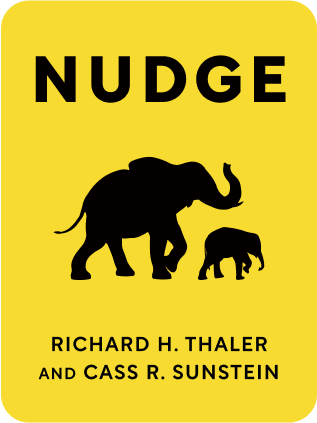

This article is an excerpt from the Shortform summary of "Nudge" by Richard H. Thaler and Cass R. Sunstein. Shortform has the world's best summaries of books you should be reading.
Like this article? Sign up for a free trial here .
What are some examples of nudges in everyday life? How do these nudges help people?
Nudges can be used for big and small choices. Examples of nudges in everyday life show how nudges can encourage better decisions and the best strategies for implementing nudges.
Read on to see some examples of nudges in everyday life and strategies for nudging.
Examples of Nudges in Everyday Life
A troubling economic trend among contemporary Americans is the declining savings rate. (In 2005, thanks to abundant, cheap credit and low interest rates, Americans spent more and the American savings rate was actually negative for the first time since the Great Depression.) Given the ever-growing strains on the Social Security system, which is likely headed for insolvency, Americans will need to save more themselves to enjoy a comfortable retirement. But how do you get people to save more without infringing the principles of economic liberty?
Thaler and Sunstein propose two examples of nudges in everyday life: automatic enrollment in savings plans and a new savings vehicle, the “Save More Tomorrow” program.
Auto-Enrollment in Savings Plans
Numerous studies have shown that employees are phenomenally poor at taking advantage of their employers’ retirement plans. One UK study concerning retirement plans that were fully funded by the employer—in other words, plans that didn’t require the employees to pay anything—found that only 51% of employees signed up. That’s tantamount to refusing free money!
Although there’s debate among economists about how much people need to save for retirement, many workers believe they’re saving too little: in one study, 68% of enrollees in a 401(k) believed their savings rate was too low. Because workers tend to want to save more but fail to do so—due to present financial pressures or diversions like temptation—a nudge here adheres to the noncoercive principles of libertarian paternalism.
One of the examples of nudges in everyday life is for 401(k) plans. Enrolling workers in 401(k) plans automatically—in other words, to make 401(k) enrollment the default option. One study found that, under an “opt-in” approach—meaning employees have to choose to enroll—participation in a particular retirement plan was 20% three months after hire, growing to 65% within thirty-six months. When the plan adopted automatic enrollment, new-employee enrollment jumped to 90% and grew to 96% within thirty-six months.
Another option in this vein is to make enrollment an “active decision”—that is, requiring new hires to check “yes” or “no” to a savings plan before receiving a paycheck—or simply making the enrollment process easier. In one study, when employees were presented with a “yes” or “no” decision to enroll in a plan with a default contribution rate and asset allocation, participation during the first four months of employment increased from 9% to 34%.
(To get already-enrolled employees to save more, firms might adjust their matching formulas: rather than match 50% up to 6% of the employee’s salary, they might match 30% up to 10%.)
Strategies Used in Examples of Nudges in Everyday Life
The examples of nudges in everyday life used strategies to ensure success. These strategies can be considered for designing other nudges.
Better Defaults
As with saving in general, investment decisions can be improved with defaults that are more sensitive to Humans’ tendency to err.
One such default is to automatically enroll employees in a “target maturity fund,” which determines its asset allocation on the basis of its investors’ prospective retirement age. Another slightly less automatic option is to give employees “lifestyle” portfolios—conservative, moderate, and aggressive—that comport with their tolerance for risk.
Better Choice Structure
Rather than offer a wide range of funds with obscure names and numbers and voluminous literature, plan sponsors can offer “tiers” of choices that cater to employees’ desired level of involvement in their investments. Tier 1 would be the default—a “target maturity” or other “managed account” tailored to the employee’s age. Tier 2 would offer a small number of funds with different asset allocations among which the employee could choose. Tier 3, intended for the savviest investor, would feature the full complement of funds.
Better Error Anticipation
Plan sponsors should expect people to forget about their accounts and fail to rebalance their allocations. Thus, along with automatic enrollment, plan sponsors should automatically adjust people’s asset allocation over time.
Better Mapping and Feedback
A glut of numerical values—rates of return, interest rates, risk ratios—can stymie even the most sophisticated investor. (Sunstein himself admits to balking at the difficulty of retirement-fund allocations.) One way to prevent confusion or resistance in enrollees is to translate the jargon and number values into easily digestible concepts.
For example, rather than bombarding investors with statistics and disclaimers, plan sponsors can attach lifestyle images to particular levels of retirement income. For one level, the image might be of a small, sparsely furnished apartment; for a higher level, the image might be a house with a swimming pool.

———End of Preview———
Like what you just read? Read the rest of the world's best summary of Richard H. Thaler and Cass R. Sunstein's "Nudge" at Shortform .
Here's what you'll find in our full Nudge summary :
- Why subtle changes, like switching the order of two choices, can dramatically change your response
- How to increase the organ donation rate by over 50% through one simple change
- The best way for society to balance individual freedom with social welfare






